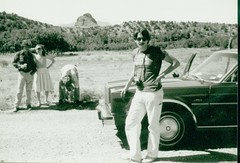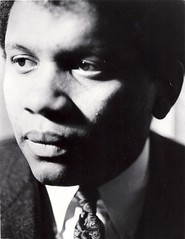 Allen Ginsberg Bob Rosenthal, front. Back, from left: Gregory
Allen Ginsberg Bob Rosenthal, front. Back, from left: Gregory
Corso, Shelley Kraut, and Peter Orlovsky holding
Aliah Rosenthal. 1980. .As National Poetry Month winds down, let’s hear more from Bob Rosenthal. Earlier, in the first and then the second installment of our interview conducted at Allen Ginsberg’s former apartment on East 12th Street, where Mr. Rosenthal worked as his secretary for nearly two decades, we heard about Ginsberg’s daily routine, his social sphere, and his love of the East Village. Now, Mr. Rosenthal recalls the poet’s romantic life, his way with strangers, and his tumultuous relationship with Peter Orlovsky – fellow poet, former lover, and longtime companion.
Allen and Peter
Harry Smith would be living here and walking through and making films, and Peter Orlovsky’s brother Julius would be here. I would listen to music and then Julius would say, “Bob, would you like me to turn the music off?” and I’d say, “No, Julius, I’m enjoying this music,” and then 30 seconds later he’d say, “Bob, would you like me to turn this music off?” And after a couple of times I’d say, “Okay, Julius, I have an idea: why don’t you turn the music off?” Denise [Mercedes] and her bandmates would try to get Julius to swear and they’d try to trick him but he was so smart and they could never trick him into saying a swear word. It was really kind of zany. Read more…
Last weekend, in one of our posts celebrating The East Village Other, Ed Sanders wrote that poet Ted Berrigan may have named the alternative newspaper after the Rimbaud line “I is an Other.” Mr. Sanders acknowledged, “Another account has Ishmael Reed coining the name.” In the comments, EVO editor Peter Leggieri wrote that Allen Katzman (who founded the paper along with Dan Rattiner and Walter Bowart) “always gave the impression that he had suggested the name ‘Other.'” After citing the reasons, Mr. Leggieri wrote, “However, if the question of origin came to a vote, I’d probably pull the lever for Ishmael Reed.” Here, now, is Mr. Reed himself, on his role in shaping The East Village Other.
 Isamu Kawai Ishmael Reed, 1967
Isamu Kawai Ishmael Reed, 1967My receiving a job as the editor of a newspaper in Newark, N.J., led to the origin of The East Village Other. I worked a number of temporary jobs from the time I arrived in New York in the fall of 1962 until I left for California in the summer of 1967. One of those jobs was that of a pollster for The Daily News. So when I went to the Department of Labor to get a temporary job, after the poll was completed, I was informed of an opening for a reporter for a new newspaper in Newark.
I had written for a newspaper in Buffalo called The Empire Star, edited by the great A.J. Smitherman, who was the target of mob violence during one of the worst riots in American history, the Tulsa riots of 1921, which left 300 blacks dead.
Smitherman believed in armed self-defense against lynching. After an interview with the investors, it was decided that I would be the editor of a newspaper that I named Advance. Although I had watched the production of a newspaper using the old linotype method while working for the newspaper in Buffalo, I hadn’t a clue about offset printing.
Walter Bowart was a bartender at Stanley’s, which was our hangout. It was owned by Stanley Tolkin who was a patron of the arts and our benefactor. Read more…
 Michelle Rick
Michelle RickYou notice them everywhere in Manhattan, but perhaps particularly in a slightly out-of-the-way neighborhood such as the East Village — middle-aged or older New Yorkers who look as if they have remained in the city that doesn’t sleep way past the limits of insomnia or common sense.
They seem a little lost in this International House of Cupcakes, among i-Stoned youth, galvanized immigrants, packed bars, and cafés where the music is always played at a volume whose message might as well be posted on a notice board outside — Adults Permitted, But Youth Preferred.
Aging is a delicate, unrewarding business at best, and some people — as a result of genes, outlook, resolution, and money — manage it better than others. To judge by the relative lack of oldsters in the East Village (anyone over 40 is a rarity on the streets after 9 p.m., and most of those are either homeless, comatose, or possibly dead), it’s obvious that this is one of the more trying places in which to grow old. Those who hang on must also confront the irony of living in an era in which they are constantly scolded that it is within their power to remain “young,” while being made to feel ancient almost all the time.
Read more…
 Allen Ginsberg Bob Rosenthal, front. Back, from left: Gregory
Allen Ginsberg Bob Rosenthal, front. Back, from left: Gregory





